Medium late hybrid of white cabbage Larsia f1
White cabbage is a must-have product. Therefore, for the gardener, not only high productivity and taste are important, but also the possibility of using the vegetable both in natural and in fermented form. The Larsia F1 green cabbage hybrid, which we will talk about, meets all these requirements.
The content of the article
Description of cabbage hybrid Larsia F1
Larsia F1 - high-yielding medium-ripening cabbage hybridcharacterized by high resistance to diseases and pest attacks.
Origin and development
Cabbage Larsia F1 was created Dutch breedersworking for the diversified multinational company Monsanto.
Reference. Monsanto Company is a world leader in the production and sale of transgenic plant seeds.
The hybrid was included in the State Register in 2007... It is recommended for both use freshand for fermentation... Originator Monsanto Holland B. V.
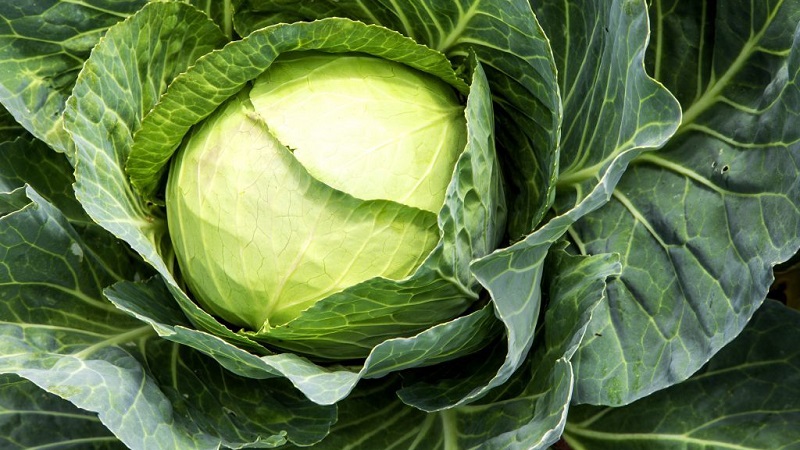
Chemical composition and useful properties
The table shows the calorie content and nutrient content in 100 g of cabbage:
| Basic substances | Vitamins | Macro- and microelements | |||
| Name | Quantity (g) | Name | Amount (mg) | Name | Amount (mg) |
| Protein | 1,9 | Beta carotene | 0,07 | Potassium | 290 |
| Fats | 0,18 | AT 2 | 0,08 | Calcium | 45 |
| Carbohydrates | 4,9 | AT 4 | 10,6 | Silicon | 57 |
| Org acids | 0,32 | AT 6 | 0,15 | Magnesium | 17 |
| Cellulose | 2,2 | FROM | 62 | Phosphorus | 32 |
| Water | 89,8 | E | 0,15 | Iron | 0,7 |
| Ash | 0,7 | RR, NE | 0,85 | Manganese | 0,18 |
| Niacin | 0,75 | Zinc | 0,5 | ||
White cabbage Larsia F1 due to its low calorie content (26 kcal) is recognized dietary product nutrition and has the following useful properties:
- normalizes gastric motility, improves microflora, prevents constipation;
- removes harmful cholesterol;
- has a beneficial effect on the cardiovascular system;
- strengthens the immune system;
- helps in the treatment of diseases of the skin, liver and spleen.
Application features
Larsia F1 is versatile in application... Already 80 days after planting the seedlings, cabbage can be used to prepare salads.
Due to its density and juiciness, the hybrid is best suited for early fermentation, salting and canning. Also, excellent cabbage rolls and others are obtained from the leaves. stews - after heat treatment, the taste of the vegetable is not lost.
Ripening period and yield
The hybrid is mid-season, so its ripening period ranges from 120 to 130 days (from transplanting seedlings in open ground before harvest).
Among mid-ripening, the hybrid is rightfully considered a high-yielding... When planting about 30 thousand seeds per 1 ha, the yield is from 40 to 50 tons.
Disease resistance
Despite the fact that only resistance to fusarium wilt is indicated in the characteristics of Larsia cabbage, it, like all hybrids created by the Dutch, does not get sick with white and gray rot, mucous and vascular bacteriosis, and is also not susceptible to attacks by thrips, aphids, cabbage and cruciferous fleas.
Cold resistance
Hybrid has an average frost resistance: ripe forks withstand short-term temperature drop down to -5 ° C.
Description of appearance and taste
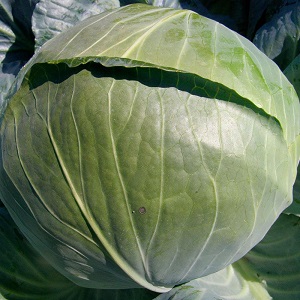 Larsia F1 has a raised rosette with 20-25 gray-green leaves... The leaf plates with short petioles are covered with a thick layer of waxy coating. The edge of the leaf is slightly wavy.
Larsia F1 has a raised rosette with 20-25 gray-green leaves... The leaf plates with short petioles are covered with a thick layer of waxy coating. The edge of the leaf is slightly wavy.
Round-flattened head of cabbage... The outer stump reaches a length of 15 cm, the inner one - 5-7 cm. Forks weighing from 4 to 6 kg are white on the cut.
Crispy leaves without thick veins have a sweetish taste, since the sugar content in them exceeds 4%.
Reference. A head of Larsia cabbage has a density index of 0.8 with a maximum value of 1.
Which regions is best suited for
State Register of the Russian Federation the hybrid was approved for cultivation in North-West, Volgo-Vyatka, Ural and West Siberian regions, but due to its unpretentiousness to climatic conditions, vegetable growers grow it throughout Russia.
Advantages and disadvantages
Benefits:
- good adaptation to unfavorable climatic conditions;
- consistently high yield;
- the output of products with an excellent presentation - 92%;
- resistance to most diseases and pest attacks;
- universality of application;
- good transportability.
disadvantages:
- exactingness to regular watering;
- short shelf life.
Difference from other varieties and hybrids
Larsia is distinguished from other mid-season varieties:
- stable yield, which is not affected by changing weather conditions;
- increased resistance to cracking;
- the possibility of using in cooking until the final ripening of the forks.
Features of planting and growing
Hybrid Larsia F1 is not intended for growing in greenhouses... In the open field, seedlings and seed planting are used. For cultivation on a small plot of land, the first method is preferable.

Preparing for landing
For seedling method will need:
- soil mixture;
- common tray;
- individual containers for picking;
- dive peg;
- spray;
- settled water.
Seed preparation
If the purchased seeds are not coated, before landing, they must undergo a phased training:
- The seeds are checked for hollowness by pouring them into a container with 3% saline solution. Those remaining on the surface are thrown away due to unsuitability.
- Calibrated and disinfected in potassium permanganate for 20 minutes.
- Soak in hot water (50 ° C) for 15 minutes, and then in cold water for 5 minutes.
- Treated with a growth stimulant for 12 hours.
- Stratify on the bottom shelf of the refrigerator for a day.
The soil mixture is purchased in a specialized store or prepared independently from equal parts of peat, sod land and river sand. After disinfection, wood ash and superphosphate are added to the soil.
Seeds are planted in a common tray according to the scheme:
- width between grooves - 3 cm;
- the distance between the seeds is 4 cm;
- planting depth - 1 cm.
After watering, the tray is covered with plastic wrap and put in a warm place.
Attention!Since Larsia F1 is a hybrid, self-grown seeds will not reproduce varietal characteristics.
Seedling preparation
After the appearance of the first shoots, the seedlings are subjected to primary hardening.placed in a well-lit cool room (+ 8 ° C) for 7 days.
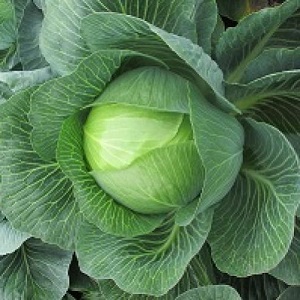 Then, before transplanting into open ground create optimal conditions for seedlings:
Then, before transplanting into open ground create optimal conditions for seedlings:
- daytime temperature - + 16 ... + 18 ° C;
- night - + 7 ... + 9 ° C.
Water the seedlings 1 time in 3 days with settled water from a spray bottle... A pick into separate containers is performed on day 10 (2 true leaves should form on the seedlings).
One week before the intended open ground transplant the seedlings begin to harden by taking out into the open air and gradually increasing the residence time.The seedlings are ready for transplanting when 4-5 true leaves appear on them.
How to make a seedless plant
On a site cleared of debris and fertilized since autumn, the soil is moistened. According to the 60x60 cm scheme, holes are made with a diameter of 4-5 cm and a depth of 2 cm... 3-5 prepared seeds are placed in each, sealed with humus and carefully watered.
Thereafter the beds are covered with foil... It is removed when 2 true leaves appear on the seedlings.
Important! Planting dates depend on the region and weather conditions, but the grower must wait until the night frosts stop.
Ground requirements
In autumn, the land at the selected site is cleared of the remnants of the previous harvest and weeds, after which they are dug to a depth of 20-25 cm.
If the soil is too dense, peat compost is introduced into it (10 kg per 1 m²).
The acidity of the soil plays an important role... For cabbage, the pH should not be below 6.5. If the acidity is higher, dolomite flour must be added to the soil. It is best to fertilize with manure (8 kg per 1 m²).
Predecessors
Hybrid Larsia F1 does not develop well in the area after cruciferous crops... No matter how well the soil is fertilized, it will not be able to replenish the substances necessary for a new planting of plants of the same species.
In addition, there will be an effect of accumulation of viruses, fungi and pests affecting the same type of agricultural crops.
Attention!In the area where other cruciferous plants were grown, cabbage can only be planted after 3 years.
Best predecessors for Larsia - peas, onions, carrots, cucumbers, beets and beans.
Timing, scheme and landing rules
Seedlings are planted in open ground 30-40 days after germinationwhen 4-5 true leaves are formed on them. The holes are made according to the scheme 60x60 cm.At the bottom of each one poured 1 tbsp mixed with a small amount of soil. l. wood ash and 1 tsp. superphosphate.
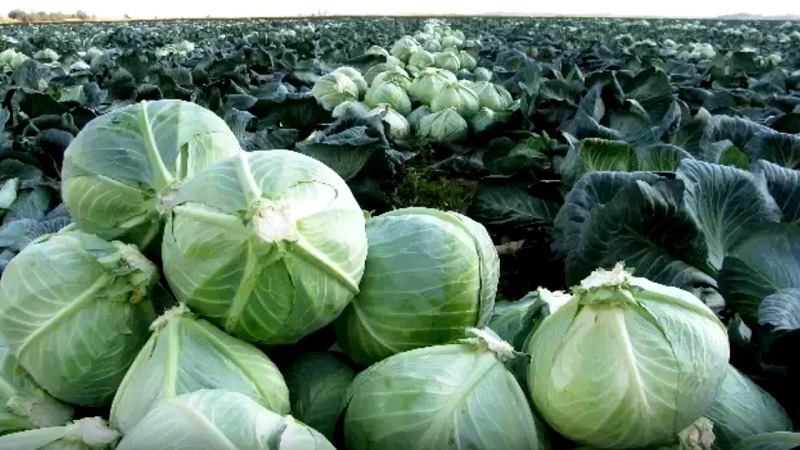
Planting density and depth
The distance between the holes for seedlings of a mid-season hybrid should be at least 60 cm... Higher planting densities will result in undershooting of medium forks.
The depth and diameter of the holes should be such that, when transferring there, the root of the seedling is completely placed there along with a lump of earth.
Growing features
White cabbage Larsia F1 is very light-requiring, therefore, it is grown only outdoors in sunny areas.
Caring for this hybrid is not much different from the agricultural technology of other mid-season varieties, but gardeners who rarely come to the country should take care of the use of drip irrigation, since Larsia requires infrequent but regular watering.
Watering mode
The first 3 weeks after transplanting seedlings into open ground, root watering is used with a frequency of 1 time in 3 days. In the future, irrigation is carried out once every 6 days. Watering is best in the evening. In hot weather, evening sprinkling can be practiced.
Loosening and hilling
Weeding, loosening and hilling cabbage is carried out the next morning after watering or rain... Hilling is done as the outer stump grows in order to heads of cabbage do not fall on their side.
Top dressing
Feed the hybrid 3 times:
- nitrogen-containing fertilizers - 2 weeks after transplanting seedlings into the ground;
- phosphate - during the formation of forks;
- fertilizers containing potassium - 20 days before the expected harvest.
Disease and pest control
It is very important to observe crop rotation in order to prevent diseases., to disinfect soil and seed.
It is better to fight pest attacks with folk remedies, and for prevention, plant around the perimeter of the site of plants rich in phytoncides (onions, garlic).
Growing difficulties
The only difficulty in growing seedlings - stretching of the stems with insufficient lighting or the absence of primary hardening. This problem can be solved by using additional lights for illumination.
Harvesting and storage
Harvesting is carried out in sunny weather 120-130 days after transplanting seedlingswhen the outer leaves begin to turn yellow. The cabbage is dug up by the root. The stump is cut with a sharp knife, leaving no more than 3 cm of the stem and 3-4 covering leaves. Before laying in the cellar, the forks are dried for 24 hours.
Features of storage and keeping quality of the hybrid Larsia F1
Keeping life at Larsia - 2-4 months... It can be increased slightly if store in a cellar only undamaged heads of medium size at a temperature of + 2… + 4 ° C and a humidity of 80%.
Reviews of experienced gardeners
Summer residents note the strong immunity of cabbage to diseases and pests and high taste.
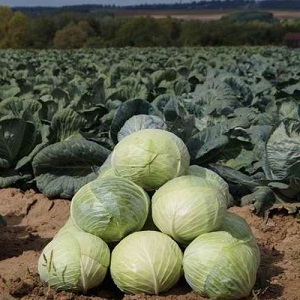 Zoya K., Oryol region: “Before planting cabbage Larsia F1, I studied the description of the variety, photos and reviews of gardeners. I am very happy with the harvest. I begin to cut the cabbage gradually at the end of August. As it turned out, they survive better in the garden than in the cellar. I let most of it be leavened ".
Zoya K., Oryol region: “Before planting cabbage Larsia F1, I studied the description of the variety, photos and reviews of gardeners. I am very happy with the harvest. I begin to cut the cabbage gradually at the end of August. As it turned out, they survive better in the garden than in the cellar. I let most of it be leavened ".
Koroshchenko Natalia, Moscow region: “Larsia was advised by a neighbor in the country last year. I was pleased with the result. Summer was normal, but insect pests did not pester. The taste is delicious, this year I will plant again ".
Conclusion
Even a novice gardener can grow a hybrid of white cabbage Larsia F1. It grows in all regions of Russia, has a strong immunity and gives a bountiful harvest. However, it is picky about watering and is not stored for long. And even if the first experience does not bring an over-harvest, the family will not be left without crispy sauerkraut.